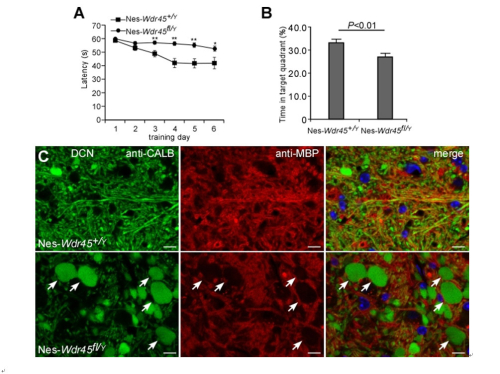The autophagy gene Wdr45/Wipi4 regulates learning and memory function and axonal homeostasis
WDR45/WIPI4, encoding a WD40 repeat-containing PtdIns(3)P binding protein, is essential for the basal autophagy pathway. Mutations in WDR45 cause the neurodegenerative disease beta-propeller protein-associated neurodegeneration (BPAN), a subtype of NBIA.
Dr. Hong Zhang’s lab at the Institute of Biophysics, Chinese Academy of Sciences generated CNS-specific Wdr45 knockout mice, which exhibit poor motor coordination, greatly impaired learning and memory, and extensive axon swelling with numerous axon spheroids. Autophagic flux is defective and SQSTM1 (sequestosome1)/p62 and ubiquitin-positive protein aggregates accumulate in neurons and swollen axons. Nes-Wdr45fl/Y mice recapitulate some hallmarks of BPAN, including cognitive impairment and defective axonal homeostasis, providing a model for revealing the disease pathogenesis of BPAN and also for investigating the possible role of autophagy in axon maintenance.
This study was published online on May 22, 2015 in Autophagy entitled “The autophagy gene Wdr45/Wipi4 regulates learning and memory function and axonal homeostasis”. Hong Zhang is the corresponding author. Yang Zhao, a post-doctor, is the first author.
This work was supported by the National Natural Science Foundation of China, grants from the National Basic Research Program of China to H.Z., and also a grant from the National Natural Science Foundation of China to Y.G.Z.. The research of Hong Zhang was supported in part by an International Early Career Scientist grant from the Howard Hughes Medical Institute.
Figure legend: Nes-Wdr45fl/Y mice exhibit learning and memory defect and axon swollen(image by Dr. Hong Zhang’s lab, IBP )


